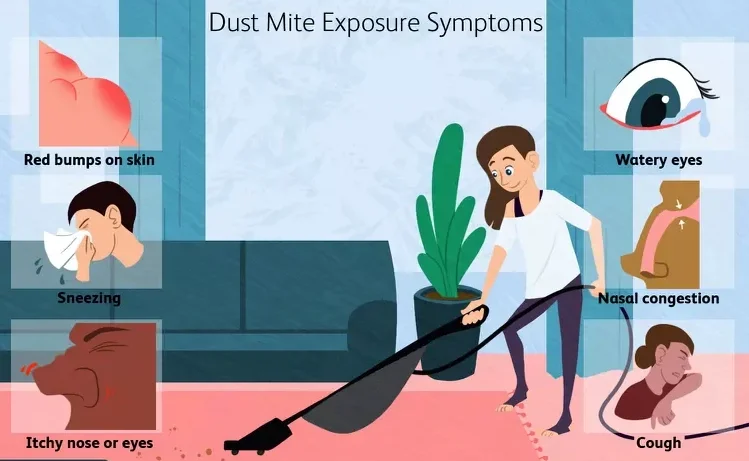
The symptoms feel like a cold that never really ends
Your nose runs. Your eyes itch. You wake up stuffy. You sneeze through the morning. But there’s no fever. No sore throat. No finish line. That’s how dust mite allergies begin—quietly. Gradually. Until they feel like part of your routine.
Dust mites don’t bite. You never see them. But their presence lingers in bedding, upholstery, carpets. Their waste triggers allergic reactions. It’s not dirt—it’s the microscopic material they leave behind. That’s what your immune system reacts to.
If you feel worse indoors—or especially in bed—you might be reacting to something you didn’t even know was there.
Bedrooms are the most common source—because that’s where dust mites thrive
They feed on skin flakes. They love warmth. They need humidity. And your bed gives them all three. Mattresses. Pillows. Duvets. Curtains. Rugs. All of it collects what they need to grow.
That’s why symptoms are often worst at night—or first thing in the morning. You breathe it in for hours while you sleep. Then wake up congested. Foggy. Drained before the day begins.
The key to relief starts where you rest.
Wash what you can—and do it often
Start with bedding. Sheets and pillowcases should be washed weekly. In hot water—at least 130°F (54°C). That temperature kills dust mites. Warm water won’t do it. Cold water keeps them alive.
Pillows and comforters need regular cleaning too. Or use allergy-proof covers that zip closed. They keep mites from getting in—or getting out. Same goes for mattresses. A well-sealed barrier makes a bigger difference than most sprays ever will.
It’s not about being perfect. It’s about being consistent.
Reduce what dust mites cling to
Dust mites need soft surfaces. That’s where they hold on. So remove what you can. Fewer stuffed animals. Fewer rugs. Fewer piles of blankets or thick curtains. The simpler your room, the fewer hiding places you leave behind.
Vacuuming helps. But only if you use a vacuum with a HEPA filter. Otherwise, you stir up allergens instead of removing them. Dust with damp cloths—not dry ones. Dry dusting just moves particles into the air.
Small changes in habits create cleaner air over time.
Humidity control is one of the most effective strategies
Dust mites need humidity to thrive. Anything over 50% gives them what they need. A dehumidifier can help. Especially in damp climates. Keep the air dry. Open windows when possible. Run fans. Use air conditioning smartly.
Bathrooms, kitchens, and basements hold moisture. But even bedrooms can become humid without airflow. A simple humidity monitor can help you track the levels. Aim for 30–50%. That zone keeps your home comfortable—but keeps mites in check.
It’s not just about temperature—it’s about moisture.
Allergy medications offer relief—but not prevention
Antihistamines reduce sneezing, runny nose, and itching. Nasal sprays relieve congestion and swelling. But they don’t remove the trigger. They help the body tolerate it. That’s different than fixing the cause.
Medications are useful. Especially during flare-ups. But long-term, the goal is exposure control. You manage the environment. So your body doesn’t have to fight every day.
Over time, fewer triggers mean fewer symptoms—even without medicine.
Immunotherapy may be the next step when medications fall short
Allergy shots—or sublingual tablets—can retrain your immune system. Gradually. Over years. They expose you to tiny amounts of allergen. Enough to teach tolerance. Not enough to cause reaction.
This isn’t for everyone. But if symptoms are constant. If medications aren’t enough. If dust mites affect your sleep, your work, your mood—immunotherapy might offer long-term relief.
It’s not instant. But it’s the closest thing to a reset.
Kids with dust mite allergies need special care
Children often spend more time on the floor. They sleep with plush toys. They bury their faces in pillows. That’s why their symptoms can be worse. Chronic cough. Congestion. Trouble sleeping. Even behavior changes.
Wash their toys regularly. Use allergen-proof bedding. Keep floors clear. Consider removing carpets from their rooms. Their environment shapes how their body feels.
It’s not just comfort—it’s daily quality of life.
Dust mite allergies aren’t seasonal—they’re constant
Unlike pollen or mold, dust mites don’t go away with weather. They live indoors. Year-round. That’s why symptoms don’t follow a seasonal pattern. They stay. And grow. Unless you intervene.
If you always feel worse inside than out—that’s your sign.
And it’s one you don’t have to ignore anymore.
